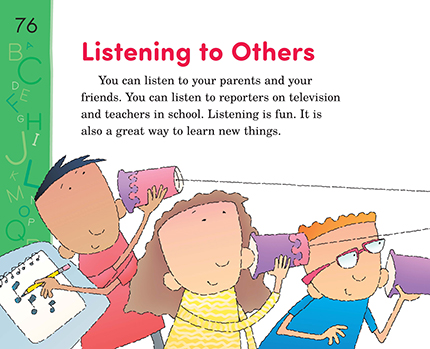Page 76 from

Start-Up Activity
Read pages 76–77 in the handbook. Then play a listening game by first reviewing “Using Capital Letters” on page 128. As a class, list the names of people and places. Next, ask volunteers to listen closely to your directions and follow them exactly:
- Hop to the list and touch the name of a friend.
- Touch the door, walk to the list, and touch the name of a place.
- Crawl to the list and touch the name of a place you would like to visit.
- Dance to the list and shout a place you don't want to visit.
- Clap your hands three times and call out a name from the list.
Enrichment Activity: Have a group of students form a line. Whisper a sentence to the first student. Have that student whisper it to the next student and so on. Compare the last version of the sentence with the original one.
Think About It
“Hearing is much easier than listening.”

Start-Up Activity
Read pages 76–77 in the handbook. Then play a listening game by first reviewing “Using Capital Letters” on page 128. As a class, list the names of people and places. Next, ask volunteers to listen closely to your directions and follow them exactly:
- Hop to the list and touch the name of a friend.
- Touch the door, walk to the list, and touch the name of a place.
- Crawl to the list and touch the name of a place you would like to visit.
- Dance to the list and shout a place you don't want to visit.
- Clap your hands three times and call out a name from the list.
Enrichment Activity: Have a group of students form a line. Whisper a sentence to the first student. Have that student whisper it to the next student and so on. Compare the last version of the sentence with the original one.
Think About It
“Hearing is much easier than listening.”